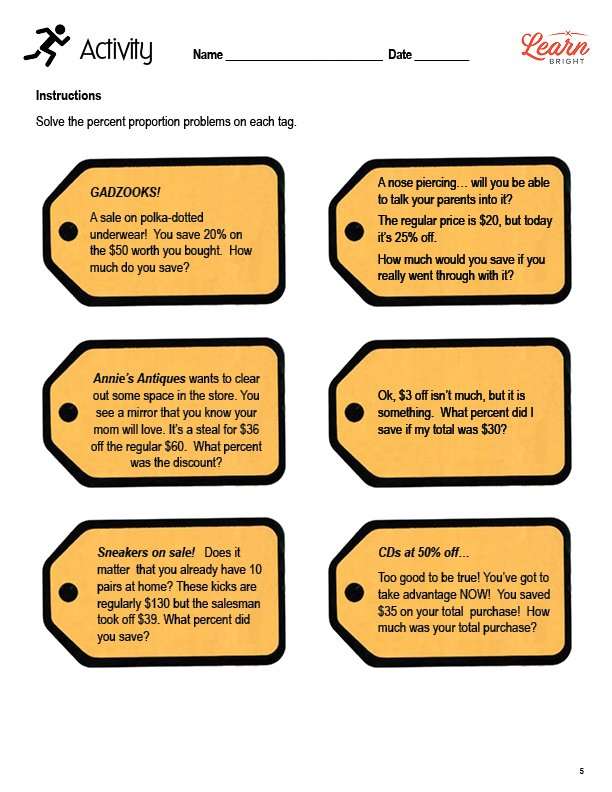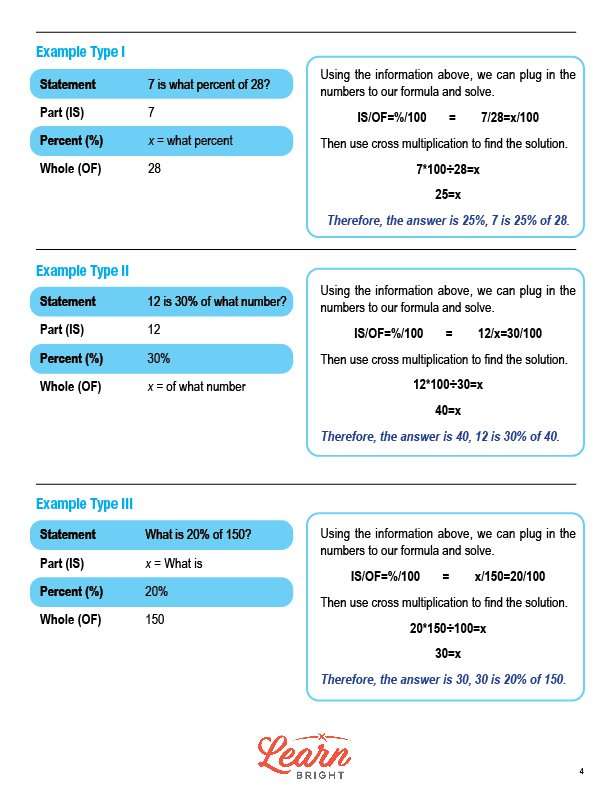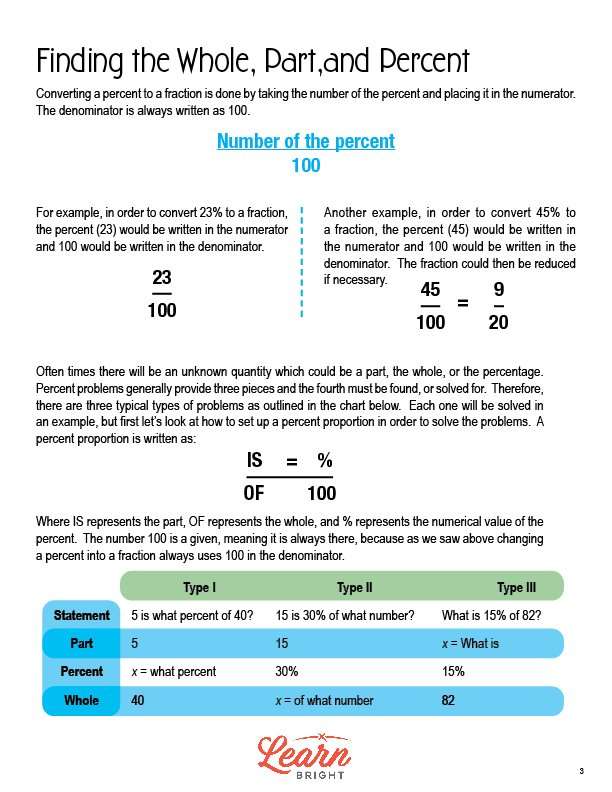Description
What our Finding the Whole, Part, and Percent lesson plan includes
Lesson Objectives and Overview: Finding the Whole, Part, and Percent begins by detailing how to change a percent to a fraction by placing the percent in the numerator and 100 in the denominator. The lesson also describes how to tackle various word problems that use language where “is” represents a part, “of” represents the whole, and % represents the numerical value of the percent. At the end of the lesson, students will be able to find the whole, part, or percent missing from the given information. This lesson is for students in 4th grade, 5th grade, and 6th grade.
Classroom Procedure
Every lesson plan provides you with a classroom procedure page that outlines a step-by-step guide to follow. You do not have to follow the guide exactly. The guide helps you organize the lesson and details when to hand out worksheets. It also lists information in the blue box that you might find useful. You will find the lesson objectives, state standards, and number of class sessions the lesson should take to complete in this area. In addition, it describes the supplies you will need as well as what and how you need to prepare beforehand.
Options for Lesson
Included with this lesson is an “Options for Lesson” section that lists a number of suggestions for activities to add to the lesson or substitutions for the ones already in the lesson. One optional addition to the lesson is to have your students practice more word problems based on various chapping events. You can have tags near stores so that your students can go shopping inside the classroom. You could also take a magnetic version of the equation that can be removed depending upon the piece missing. Finally, you could have your students find problems around the room like a scavenger hunt.
Teacher Notes
The teacher notes page includes lines that you can use to add your own notes as you’re preparing for this lesson.
FINDING THE WHOLE, PART, AND PERCENT LESSON PLAN CONTENT PAGES
Finding the Whole, Part, and Percent
The Finding the Whole, Part, and Percent lesson plan includes two content pages. To convert a percent to a fraction, we take the number of the percent and place it in the numerator. We always write the denominator as 100.
For example, if you wanted to convert 23% to a fraction, we write the percent (23) in the numerator and 100 in the denominator: 23/100. Sometimes, we will have to reduce the fraction. For example, we convert 45% to a fraction by writing it as 45/100. We can then reduce it to 9/20.
Sometimes, there is an unknown quantity like a part, whole, or percentage. Percent problems often ask for one missing number. To solve these problems, we need to understand how to write a percent proportion. We write a percent proportion as: is / of = % / 100. Here, is represents the part, of represents the whole, and % represents the numerical value of the percent.
There are three typical types of percent problems. The first type is written in the following format: 5 is what percent of 40? For this problem, 5 is the part, the x is asking you to find the percent, and the whole is 40.
The second type is written in the following format: 15 is 30% of what number? For this problem, 15 is the part, 30% is the percent, and the x is asking you to find the whole.
The third type is written in the following format: What is 15% of 82? For this problem, the x is asking you to find the part, 15% is the percent, and the whole is 82.
The lesson walks through example problems for each type of percent problem one-by-one. For the first type, the example problem is: 7 is what percent of 28? To solve, we plug in the numbers to the percent proportion formula: 7/28 = x/100. We then use cross multiplication to solve: 7 x 100 / 28 = x, so x = 25. The answer is 25%.
For the second type, the example problem is: 12 is 30% of what number? To solve, we plug in the numbers to the percent proportion formula: 12/x = 30/100. We then use cross multiplication to solve: 12 x 100 / 30 = x, so x = 40. The answer is 40. 12 is 30% of 40.
Finally, for the third type, the example problem is: What is 20% of 150? To solve, we plug in the numbers to the percent proportion formula: x/150 = 20/100. We then use cross multiplication to solve: 20 x 150 / 100 = x, so x = 30. The answer is 30. 30 is 20% of 150.
FINDING THE WHOLE, PART, AND PERCENT LESSON PLAN WORKSHEETS
The Finding the Whole, Part and Percent lesson plan includes four worksheets: an activity worksheet, a practice worksheet, a homework assignment, and a quiz. You can refer to the guide on the classroom procedure page to determine when to hand out each worksheet.
TAGS ACTIVITY WORKSHEET
The activity worksheet asks students to solve six percent proportion word problems.
PERCENT PROPORTION PRACTICE WORKSHEET
For the practice worksheet, students will solve percent proportion problems.
FINDING THE WHOLE, PART, AND PERCENT HOMEWORK ASSIGNMENT
The homework assignment asks students to solve percent proportion problems, some of which are word problems.
QUIZ
This lesson also includes a quiz that you can use to test students’ understanding of the lesson material. For the quiz, students will solve four percent proportion problems.
Worksheet Answer Keys
This lesson plan includes answer keys for the activity worksheet, the practice worksheet, the homework assignment, and the quiz. If you choose to administer the lesson pages to your students via PDF, you will need to save a new file that omits these pages. Otherwise, you can simply print out the applicable pages and keep these as reference for yourself when grading assignments.










